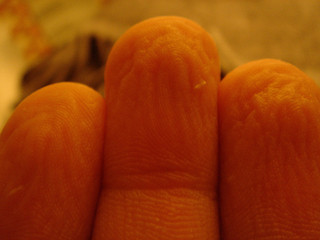We're open daily! View holiday hours
Science News
Wrinkly Fingers
January 24, 2013
by Zuberoa Marcos

British scientists have discovered a possible reason why skin wrinkles in water. According to a study reported in Biology Letters, puckered skin may have helped our ancestors grasp slippery food and keep their footing on treacherous ground.
When our hands or feet are in water for a long time, wrinkles form in the skin. It was once believed that this was the result of water from the external source passing into the outer layer of the skin, making it swell up. However, recent investigations have shown that the formation of these wrinkles is an active process arising from inside the body. Fingertips shrink when they wrinkle because the blood vessels inside them contract. The effect is controlled by the autonomic nervous system, which also governs breathing and heart rate.
To study the benefits of wrinkles, researchers tasked 20 people with grasping and relocating marbles from one bucket of water to another. The marbles were plucked one at a time with the forefinger and thumb of the right hand, and passed into the thumb and forefinger of the left hand through a hole in a screen separating the buckets.
Scientists timed the participants completing the task with dry, unwrinkled- hands, and then again with fingers made wrinkly from a 30-minute warm water bath. The task took between 90 and 150 seconds to complete, but in trials involving wrinkled fingers, participants moved the marbles an average of 15 seconds faster compared with trials that began with dry hands. The team found there was no advantage from ridged fingers when moving dry objects. This suggests that wrinkles improve our grip on objects under water, and may also help us deal with wet, slippery surfaces in general.
“It could be working like treads on your car tires which allow more of the tire to be in contact with the road and gives you a better grip.” says co-author Tom Smulders, an evolutionary neurobiologist at Newcastle University and co-author of the study.
The findings support the theory that wrinkled fingers are a trait evolution has selected because it confers us some sort of advantage. However, it raises the question of how, and from which species, humans inherited their wrinkling skin.
The trait’s evolution is not the only mystery that remains. “This raises the question of why we don’t have permanently wrinkled fingers and we’d like to examine this further,” says Smulders. “Our initial thoughts are that this could diminish the sensitivity in our fingertips or could increase the risk of damage through catching on objects.”
Zuberoa Marcos is a former biologist and current science writer based in Barcelona. She writes articles regularly for Science Today.
¿Por qué se arrugan los dedos en el agua?
Por Zuberoa Marcos
Científicos británicos afirman haber descubierto por qué se nos arruga la piel en el agua. Según un estudio publicado en Biology Letters, las arrugas en la piel podrían suponer una adaptación evolutiva que habría ayudado a nuestros antepasados a agarrar alimentos resbaladizos y a mantener el equilibrio en terrenos húmedos.
Cuando sumergimos las manos o los pies en el agua durante mucho tiempo, nos salen arrugas. Al principio se creía que ésto era el resultado del paso de agua a la capa externa de la piel que hacía que se hinchase. Investigaciones recientes han demostrado que la formación de estas arrugas es un proceso activo. Aparecen porque los vasos sanguíneos se contraen. Es un efecto controlado por el sistema nervioso autónomo, el mismo que regula nuestra respiración y la frecuencia cardiaca.
Para estudiar los beneficios que nos aportan estas arrugas, los investigadores pidieron a 20 personas para cogiesen canicas de diferentes tamaños inmersas en un cubo de agua con la piel seca y sin arrugas o con los dedos de las manos arrugados después de haberlas sumergido en agua caliente durante media hora.
Los voluntarios tenían que mover las canicas de un recipiente a otro. Coger los objetos de uno en uno con el dedo índice y el pulgar de la mano derecha, pasarlos a través de un agujero en una pantalla que separaba ambos recipientes y depositarlo con el pulgar y el dedo índice de la mano izquierda.
Los científicos midieron el tiempo empleado en realizar la tarea en ambas situaciones. En promedio, los participantes invirtieron entre 90 y 150 segundos en completar la acción, pero los que tenían sus dedos arrugados movieron los objetos 15 segundos más rápido, en promedio, que los que tenían las manos secas. Cuando se trataba de mover objetos secos no había diferencias entre uno y otro equipo. Estos resultados sugieren que las arrugas en la piel mejoran nuestro control sobre objetos y superficies húmedas en general.
“Podrían tener una función similar a las líneas de las ruedas de un coche, que le proporcionan un mayor agarre” dijo a Tom Smulders, neurobiólogo evolutivo de la Universidad de Newcastle y autor del estudio.
Los resultados apoyan la teoría de que los dedos arrugados son una característica seleccionada por la evolución porque nos confiere algún tipo de ventaja. Sin embargo, plantea el interrogante de de qué especie y cómo heredamos los seres humanos las arrugas en la piel.
No es el único misterio que queda. “Nos gustaría examinar por qué no tenemos permanentemente los dedos arrugados. Nuestra hipótesis de partida es que ésto podría disminuir la sensibilidad en los dedos o podría aumentar el riesgo de daños a través de la captura de objetos” finalizó Smulders.
Zuberoa Marcos es bióloga molecular y actualmente trabaja como productora de TV y periodista científica. Escribe de forma regular para Science Today.
Image: minusequalsplus/Flickr